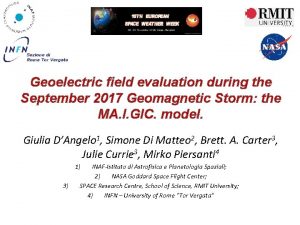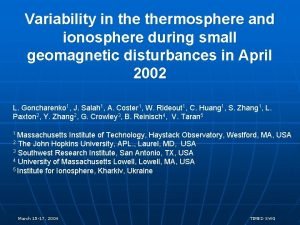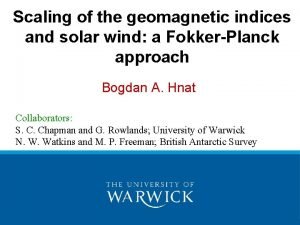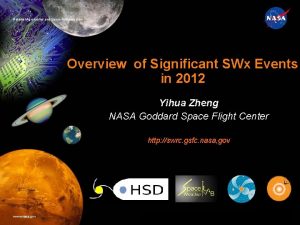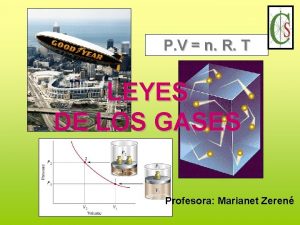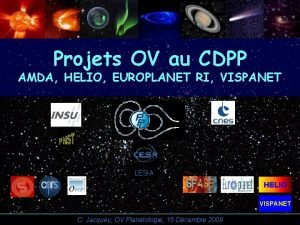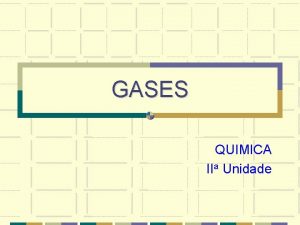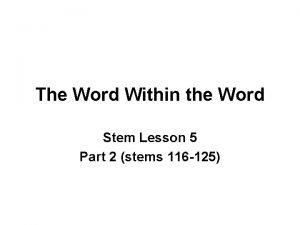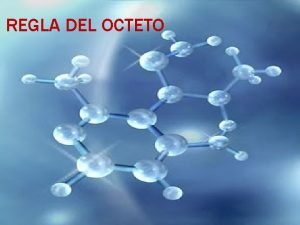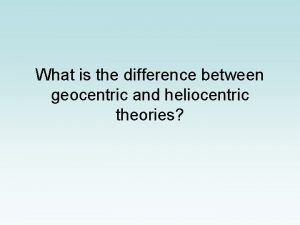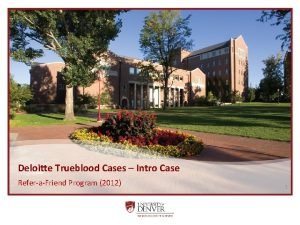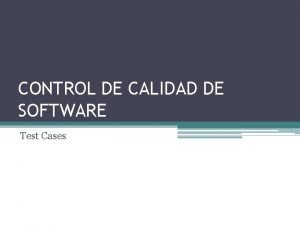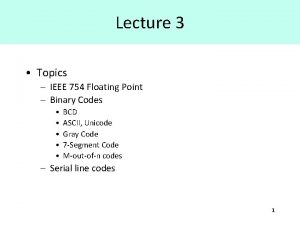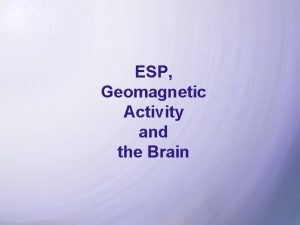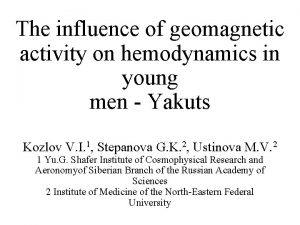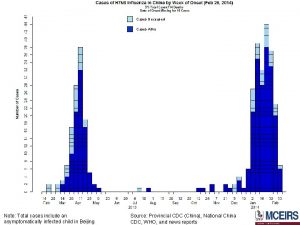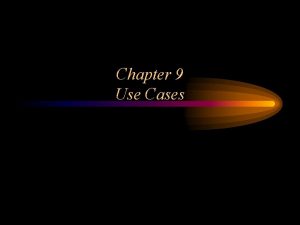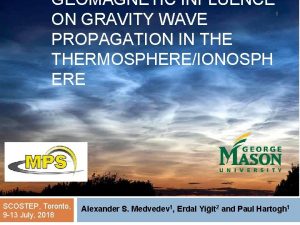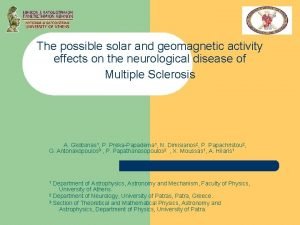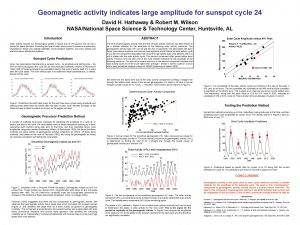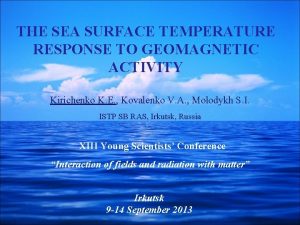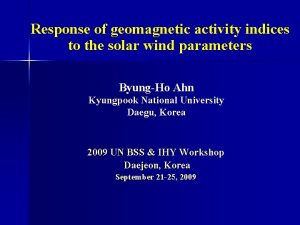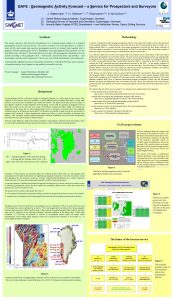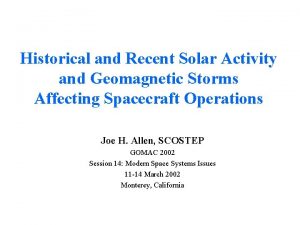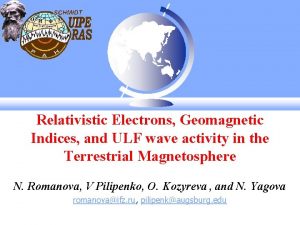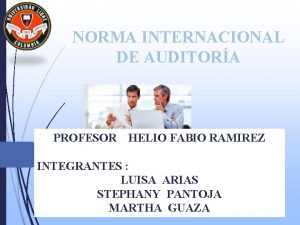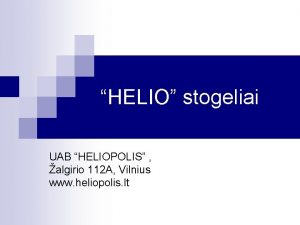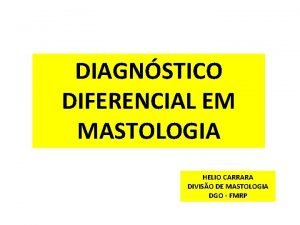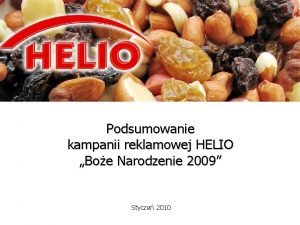Helio Geomagnetic Activity Influence on Cardiological Cases Ch

























- Slides: 25

Helio – Geomagnetic Activity Influence on Cardiological Cases Ch. Katsavrias 1, P. Preka-Papadema 1, X. Moussas 1, Th. Apostolou 2, A. Theodoropoulou 1, A. Hilaris 1 and Th. Papadima 3 1 National and Kapodistrian University of Athens, Faculty of Physics, Department of Astrophysics, Astronomy and Mechanics 2 St. Panteleimon General Hospital of Nicaea, Piraeus 3 Evagelismos' General Hospital of Athens

Space Weather "The conditions and processes occurring in space which have the potential to affect the near Earth environment. Space Weather processes can include changes in the interplanetary magnetic field, coronal mass ejections from the Sun and disturbances in Earth's magnetic field. The effects of space weather can range from damage to satellites to disruption of power grids on Earth".

Heliobiology The effect of solar activity in human health 1. Photic solar effects 2. Non-photic solar effects

Previous Works • 604 heart attack incidents from the cardiological department of KAT hospital in Athens (18/5/1992 until 1/6/1995) • Patients with cardiological problems from the emergency department of two general hospitals: Lamia and Veria for selected months of the solar cycle 23 (1997 – 2007).

Acute Coronary Syndromes (ACS) The pathophysiological mechanism is formed by the under perfusion of myocardial, due to important minimization of the blood flow in the coronary arteries, resulting in the partial or fully necrosis of myocardium. The classification of patients is based on the morphology of the electrocardiogram in two categories: 1. Patients with acute chest pain and persistent (> 20 min) ST--segment elevation. This is termed ST elevation ACS (STE--ACS) and generally reflects an acute total coronary occlusion which, mostly, develop a ST elevation MI (STEMI). 2. Patients with acute chest pain but without persistent ST-segment elevation. This is dubbed non-ST-elevation ACS (NSTE--ACS) and the diagnosis is based on the measurement of troponine enzyme. Also, a NSTEMI event can be caused by dynamic obstruction (eg. Vasospasm) and extrinsic factors leading to poor coronary perfusion (eg. hypotension, hypervolaemia or hypoxia). NSTEMI represents the majority of ACS.

Data Selection • OMNIWEB: For the number of sunspots (Rz), the solar wind speed (VSW) and the geomagnetic index DST, AE and Kp. • NGDC GOES: For the daily number of solar flares by intensity class (intense solar flares of X and M class, hence forward X - M and weak flares of B and C class, henceforward B - C). • SOHO/LASCO: For the daily number of CMEs (including the highly geoeffective Full and Partial Halo (width >200 degrees) hence P-H CMEs). There are two data gaps in this database in 25/6/199814/10/1998 and 1/1/1999 -4/2/1999. • The patient records of the 2 nd Cardiologic Department of the General Hospital of (Piraeus) 'St. Panteleimon', Greece: For the daily number of ACS cases, STE - ACS and NSTE - ACS (hence ST and NST respectively)

Analysis Method • Pearson’s Product Moment Correlation Coefficient • Morlet Wavelet Analysis

Figure 1. Monthly number of ACS{NST (a) and ST (b), sunspots (c), flares (d), X – M flares (e), B flares (f), CMEs (g), P-H CMEs (h) and B - C flares (j). The grey curves represent Savitzky - Golay smoothing with a window of 12 points. Flares (185) August 2001 and (217) January 2005 X-M flares (37) July 2000, September 2001 and (36) August 2002 CMEs (177) August 2002 (161) April 2007 P-H CMEs (89) September 2002, (91) June 2000 and (92) March 2001 NST (72) October 2002 Katsavrias et al, 2012

Figure 2. Correlation coefficients with 12 months' time lag between smoothed monthly values of: NST cases and CMEs (a), NST cases and X- M flares (b), ST cases and B flares (c). Correlation coefficients with 18 months' time lag between smoothed monthly values of: NST cases and CMEs (d), NST cases and X- M flares (e), ST cases and B flares (f). The dash ellipse represents the confidence level which is above 99%. Katsavrias et al, 2012

Based on the discussion of the previous section, we focus on characteristics periods of the solar cycle 23 as marked by peaks in active phenomena. We proceed therefore to analyze in more detail three intervals of interest as follows: 1. The August--September 2002 peak: In this period appear the number of CMEs maximum, the number of P-H CMEs and the number of X-M flare peaks. Shortly after, in October 2002 the global maximum of NST cases (72) is recorded; a little later in November 2002 an ST monthly peak (32) is recorded. This was deemed significant as only 6 times after 2002 ST exceeds 32. 2. The Active Period October--December 2003: The most intense GMS of cycle 23 (220~n. T) was recorded in October 30, 2003, within a period of extremely high heliogeomagnetic activity (there were Solar Energetic Particle events and three Ground Level Enhancements of Cosmic Rays in October 28 and 29 and in November 2, 2003) at the beginning of the descending phase of the solar cycle. 3. The year 2005: Although it was near the solar minimum, the quiet interval was interrupted by a period of extreme helio-geomagnetic activity in January 2005 with the maximum GLEs (Ground Level Enhancements of Cosmic Rays) of the past decades and a period of increased geomagnetic activity in April--September. This succession of intense, medium and small activity presents a unique opportunity of comparative study of the impact of this activity on ACS.

Figure 3. Daily number of DST index, solar wind speed (VSW) and ACS (NST and ST) cases during the period August 2002 -February 2003. The grey curve represents the smoothed values (Savitzky. Golay smoothing with a window of 7 days). The ACS cases come from the database of General Hospital of the town of Nicaea (Piraeus) 'St. Panteleimon'. Katsavrias et al, 2012

Figure 4. Daily distribution of DST and date labels of increased of NST ( 5) and ST (4) cases in 1/8/2002 - 8/2/2003. Katsavrias et al, 2012

Figure 5. Daily number of DST index, solar wind speed (VSW) and ACS (NST and ST) cases during the period October-December 2003. The grey curve represents the smoothed values (Savitzky. Golay smoothing with a window of 7 days). The ACS cases come from the database of General Hospital of the town of Nicaea (Piraeus) 'St. Panteleimon'. Katsavrias et al, 2012

Figure 6. Daily distribution of DST and date labels of increased of NST ( 5) and ST (4) cases in 1/10/2003 - 31/12/2003. Katsavrias et al, 2012

Figure 7. Daily number of DST index, solar wind speed (VSW) and ACS (NST and ST) cases during the year 2005. The grey curve represents the smoothed values (Savitzky-Golay smoothing with a window of 7 days). The ACS cases come from the database of General Hospital of the town of Nicaea (Piraeus) 'St. Panteleimon'. Katsavrias et al, 2012

Figure 8. Daily distribution of DST and date labels of increased of NST ( 5) and ST (4) cases in 1/1/2005 - 31/3/2005. Katsavrias et al, 2012

Figure 9. Daily distribution of DST and date labels of increased of NST ( 5) and ST (4) cases in 1/4/2005 - 31/7/2005. Katsavrias et al, 2012

Figure 10. Daily distribution of DST and date labels of increased of NST ( 5) and ST (4) cases in 1/8/2005 - 31/12/2005. Katsavrias et al, 2012

Figure 11. Daily distribution, wavelet power spectrum and global wavelet spectrum of smoothed ACS (upper panel), NST (middle panel) and ST cases (bottom panel).

Figure 12. Daily distribution, wavelet power spectrum and global wavelet spectrum of CMEs (upper panel) and P-H CMEs (bottom panel).

Figure 13. Daily distribution, wavelet power spectrum and global wavelet spectrum of Flares (upper panel), X-M Flares (middle panel) and B Flares (bottom panel).

Figure 14. Daily distribution, wavelet power spectrum and global wavelet spectrum of DST Index (upper panel), Kp Index (middle panel) and AE Index (bottom panel).

Table 1. Correlation coefficients between global wavelet spectrum of Helio-geomagnetic parameters and ASC cases. NST ST Vsw 0. 39 ± 0. 01 0. 54 ± 2 10 -4 Kp 0. 63 ± 10 -5 0. 80 ± 2 10 -10 AE 0. 74 ± 2 10 -8 0. 90 ± 10 -15 DST 0. 76 ± 9 10 -9 0. 70 ± 4 10 -7 CME 0. 93 ± 0. 00 0. 83 ± 2 10 -11 P-H CME 0. 93 ± 0. 00 0. 83 ± 2 10 -11 Flares 0. 60 ± 3 10 -5 0. 83 ± 10 -11 B Flares 0. 83 ± 10 -11 0. 91 ± 0. 00 C Flares 0. 58 ± 7 10 -5 0. 79 ± 10 -9 BC Flares 0. 64 ± 7 10 -6 0. 86 ± 8 10 -13 X-M Flares 0. 51 ± 6 10 -4 0. 69 ± 7 10 -7

Conclusions • The calculated correlation coefficient using smoothed monthly values when the ACS time - series was lagging by 12 months behind the Helio geomagnetic activity are: 1. 2. 3. 0. 79 ± 0. 00 between CME and NST, 0. 66 ± 2 10 -16 between NST - intense flares (X and M) and 0. 66 ± 4 10 -16 between ST--faint flares (B type). • For the three periods of interest examined, we have studied the phase (pre - phase, main, recovery) of the storm that coincides with increased ACS cases. : 1. 2. 3. 4. 60% of increased ACS cases coincide with the storm recovery phase; the probability rises to 75% for the NST cases. Only 3 dates (4. 5%) with increased ACS cases took place at the main phase 6 dates (9% of the increased cases) took place at the pre-phase of the storms We note a significant number of increased ACS cases (15%) in periods of high solar wind speed (>600 Km/s) without geomagnetic storms.

Thank you for your attention
 Sale 234m gic emtekdagareuters
Sale 234m gic emtekdagareuters Geomagnetic
Geomagnetic Building statistics
Building statistics Geomagnetic
Geomagnetic Criminal cases vs civil cases
Criminal cases vs civil cases P * v = n * r * t
P * v = n * r * t Helio
Helio Num dia de tempestade a pressão atmosférica caiu de 760
Num dia de tempestade a pressão atmosférica caiu de 760 Helio oiticica
Helio oiticica Hélio costa manso true love
Hélio costa manso true love Words with the stem scope
Words with the stem scope Octetos expandidos
Octetos expandidos Define heliocentric
Define heliocentric Reactants products and leftovers
Reactants products and leftovers Activity 3 explore me more
Activity 3 explore me more Activity on node vs activity on arrow
Activity on node vs activity on arrow Debye huckel equation
Debye huckel equation 1index
1index Activity 1 introductory activity
Activity 1 introductory activity Activity 2 finding the sequence
Activity 2 finding the sequence Deloitte trueblood
Deloitte trueblood Mimoza ristova
Mimoza ristova Test case que es
Test case que es Qm for windows
Qm for windows Factoring cases
Factoring cases Ieee 754 floating point
Ieee 754 floating point
